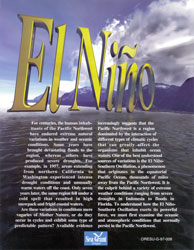 NEWPORT – October is Octopus Month at OSU’s Hatfield Marine Science Center, and to celebrate the occasion – and give the animal mental and physical stimulation – aquarists have taught Squirt, the resident giant Pacific octopus, to paint.
NEWPORT – October is Octopus Month at OSU’s Hatfield Marine Science Center, and to celebrate the occasion – and give the animal mental and physical stimulation – aquarists have taught Squirt, the resident giant Pacific octopus, to paint.
Aquarist Kristen Simmons, Aquarium Science student from Oregon Coast Community College, was the brains behind the mechanism, which allows the octopus to remotely manipulate a number of paint brushes against a canvas sitting outside its tank, while working to open a plastic toy containing food treats. “I did this to combine animal enrichment and public education.” she said, “The art gives people a different way to experience this animal behavior.”
“While a painting octopus is very entertaining and captures our imaginations,” explained Dr. Tim Miller-Morgan, aquatic veterinarian for Oregon Sea Grant and the OSU Veterinary School, “the real purpose behind this activity is to provide behavioral enrichment for these very curious and intelligent animals.”
The giant Pacific octopus exhibit has been a centerpiece at the HMSC Visitor Center since 1965. Generations of visitors have fond remembrances of seeing the octopus for the first time, and for the past few years, thousands more all over the world have enjoyed viewing the animals over a live, streaming OctoCam. “The octopus holds a very special place in the hearts of our visitors” said Becca Schiewe, Volunteer Coordinator for the Visitor Center. “Coming face to face with such an intriguing and intelligent animal opens people up to learning more about the wonder and mystery of the ocean.”
Evidence for octopus intelligence abounds: the leggy invertebrates can use tools, solve problems, and display remarkable curiosity. HMSC Aquarists strive to come up with new ways to challenge the animals during their tenure in the exhibit tank, including toys and puzzles – with a tasty bit of fish tucked inside – the octopuses quickly learn to open and disassemble. The painting mechanism takes the
Squirt’s colorful paintings have already captured the attention of community artists in Newport, and several have volunteered to collaborate with Squirt on shared works. Alex Krupkin, artist and molecular biologist based at HMSC, was the first to collaborate with Squirt. “The octopus’s artistic style is really bold, yet open to interpretation…the opportunity to participate in this collaboration is pretty exciting,” he said.
The octopus will create one painting a week during the month of October. Visitors who make an additional donation to the Visitor Center Octopus Fund will be entered into a weekly drawing for Squirt’s paintings and other prizes, including marine themed art from local artisans, and an “up close and personal” octopus encounter at HMSC.
On Oct. 20, the Visitor Center will celebrate Octopus Day, a showcase of all things octopus, including children’s activities, face painting, special guest speakers, and a 1 pm octopus feeding at 1 pm.
Learn more:




 A developing El Niño pattern is likely to bring higher temperatures – and less snow – to Oregon and the Pacific Northwest this winter, according to scientists at the OSU-based Oregon Climate Service.
A developing El Niño pattern is likely to bring higher temperatures – and less snow – to Oregon and the Pacific Northwest this winter, according to scientists at the OSU-based Oregon Climate Service.